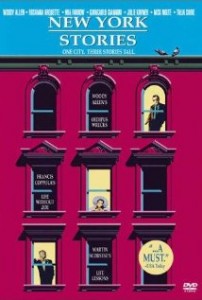From the Chicago Reader (March 3, 1989). — J.R.
NEW YORK STORIES
*** (A must-see)
“Life Lessons”
Directed by Martin Scorsese
Written by Richard Prince
With Nick Nolte, Rosanna Arquette, and Patrick O’Neal.
“Life Without Zoe”
Directed by Francis Coppola
Written by Francis Coppola and Sofia Coppola
With Heather McComb, Talia Shire, Giancarlo Giannini, Don Novello, and Selim Tlili.
“Oedipus Wrecks”
Directed and written by Woody Allen
With Woody Allen, Mae Questel, Mia Farrow, and Julie Kavner.
With the exception of the recent and disappointing Aria, there have been no films made of late that consist of thematically related sketches, compilations of episodes by one director or more. New York Stories may help make the form fashionable again. The arbitrariness of the standard running time of features, at least from an artistic standpoint, makes a good many movies needlessly padded and a few others shorter than they should be, while the difficulty in marketing shorts discourages most commercially established filmmakers from even attempting to work in the form. New York Stories came about because Woody Allen wanted to make a short and decided that incorporating it within an anthology would make it commercially feasible.
The usual argument made against sketch movies is that they’re invariably uneven — which is true enough but also rather beside the point. Read more
This review originally appeared in the July 14, 1997 issue of In These Times. — J.R.
Pynchon’s Tangle

Mason & Dixon
By Thomas Pynchon
Henry Holt
773 pp. $27.50
It’s always been one of the paradoxes of Thomas Pynchon’s fiction that he combines the encyclopedic researches of a polymath with the rude instincts of a populist. V., The Crying of Lot 49, Gravity’s Rainbow, the stories in Slow Learner, Vineland, and now Mason & Dixon synthesize an awesome array of scientific and historical speculation while steadily sabotaging, with a compulsive anti-elitism, every effort to marshal this material into the stuff of high art. Fusing studied literary pastiche with collegiate humor and flip song lyrics, philosophical soul-searching with barroom brawls and locker-room asides, Pynchon’s intricate and unwieldy narratives tend to define and confound boundaries in the same gesture. So it stands to reason that this epic about American origins, focused on a couple of low-level line drawers (the 18th century executors of the Mason-Dixon Line), winds up favoring sprawl over progression, digression over linear advance.
It’s surely too soon to post final verdicts about a novel that reportedly was almost a quarter of a century in the making. Read more
The following article, which originally appeared in the April 20, 1990 issue of the Chicago Reader, without any star rating, is the only time I can recall writing at length in the Reader about an American TV series. (An edited version of this piece appears in a 1995 collection edited by David Lavery for Wayne State University Press, Full of Secrets: Critical Approaches to Twin Peaks, under the title “Bad Ideas: The Art and Politics of Twin Peaks“.) From a vantage point of almost two decades later, I wouldn’t be as quick today to insist that David Lynch’s work is devoid of any social commentary. What he has to say about the Hollywood community alone, especially in Inland Empire (2006), shows that he’s no longer as detached as he was.
Another invaluable tool for re-evaluation is the recent and superbly appointed Blu-Ray box set devoted to Twin Peaks. Despite some misgivings about the show’s second season (see, for instance, Martha Nochimson’s demurrals in her 1997 The Passion of David Lynch about some of the ways the show “perverted” Lynch’s original designs and conceptions), I continue to find much of it very absorbing. The same is true, so far, about the so-far uneven third season, despite the brilliance of the third episode. Read more
From the January 25, 2007 issue of the Chicago Reader. — J.R.
INLAND EMPIRE ****
DIRECTED AND WRITTEN BY DAVID LYNCH WITH LAURA DERN, JUSTIN THEROUX, JEREMY IRONS, KAROLINA GRUSZKA, HARRY DEAN STANTON, AND GRACE ZABRISKIE

David Lynch’s first digital video, almost three hours long, resists synopsizing more than anything else he’s done. Some viewers have complained, understandably, that it’s incomprehensible, but it’s never boring, and the emotions Lynch is expressing are never in doubt. Asked many years ago about the origins of the nightmarish Eraserhead (1978), his first and best feature, he forthrightly replied, “Philadelphia.” If asked the same thing today about the no less nightmarish Inland Empire, he might say, “Hollywood.”
Many of my colleagues believe Lynch’s best early feature is Blue Velvet (1986), which I regard as a gripping but limited piece of designer porn. Like his more offensive Wild at Heart and his more charming TV series Twin Peaks (both 1990), Blue Velvet offers a vivid illustration of how a man can turn his most lurid puritanical obsessions into clout and big money — and get an audience to wallow in those obsessions without thinking about them very hard. It has little of the meditative integrity and private intensity of Eraserhead, but then little in his work before Inland Empire did. Read more



